The strange and high-speed world of racing on drones
Translation of an article from The New Yorker dedicated to FPV quadcopter competitions and their participants. For the convenience of reading and commenting, we have divided the text into parts, this is the first passage.

In a canyon in the foothills of the Rockies, near Fort Collins, Colorado, a young man named Jordan Temkin runs a drone. On Temkin video glasses that broadcast video from a camera built into the drone, and in his hands he holds a console with a pair of joysticks that control the direction, roll, pitch, yaw, and flight speed. The pilot puts the drone on the gravel at his feet. Just below the river flows the Cash-la-Paudre. The canyon slopes rise ninety meters above it. Temkin gives the command, and the drone instantly takes off to the top of the canyon. Then he soars above, from where a person seems to be a small figure sitting aboard a car. The shadow of the drone flashes on the surface of the rocks, sweeping at a speed of 128 km / h. Then the pilot lowers the apparatus to the river and he flies half a meter from the water. The river shimmers with silver in the sun. Temkin again raises the drone higher and turns into a nearby canyon.
The stock of the battery powering the drone is about three minutes. Before the time comes, Temkin lowers the drone next to him. Landing on the gravel sounds like a knock from dropping a plastic toy. Yes, and the drone itself looks like a toy. Temkin calls him a "quadrocopter." The quadcopter has four plastic propellers, each at the corner of a cruciform plastic frame. Usually such drones are called “quads”. The whole device would easily fit in the package for one slice of pizza. An immeasurable amount of scientific and technical discoveries, like a huge inverted pyramid, converge at this tiny, toy point.
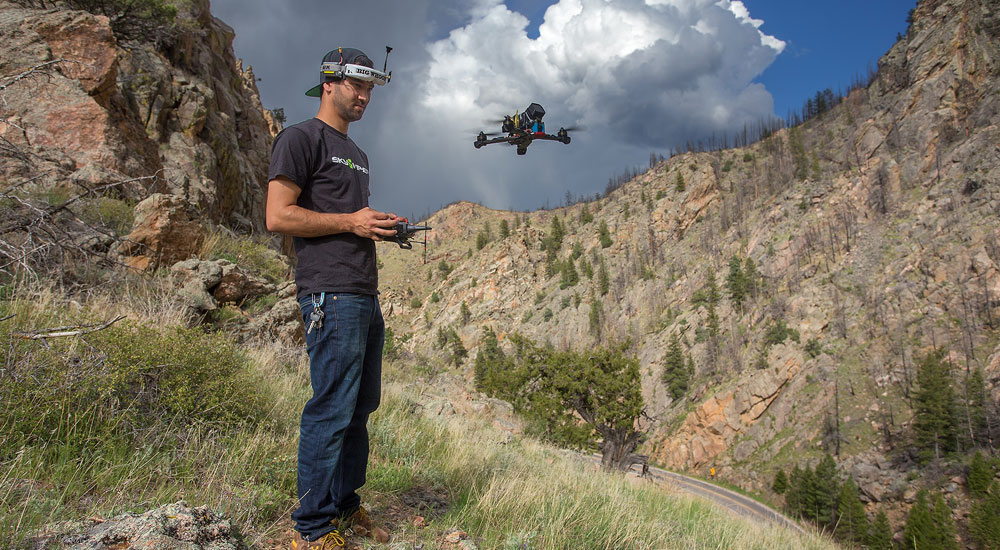
Jordan Temkin, photo by Engadget
')
At twenty-six, Temkin retained those sweet, serene manners of a beloved child, but not a spoiled child. He is about eighty meters tall, dark-haired, with Asian features. Dressed in black jeans, a black T-shirt with a small silver “DRL” emblem, a dark blue sweatshirt with open zipper, and white and yellow sneakers. When people ask Temkin what he does for a living, he answers that he controls toy helicopters. He concluded that this is a good description of his new vocation. Temkin is a professional drone pilot, one of the best in the new sport. To practice, he flies in the mountains as often as he can.
Temkin often flies with Zahri Thayer, his housemate in Fort Collins, other professional pilots. Thayer is somewhat denser than Temkin, with magical blue eyes and a full beard. Both come from the west coast of the United States: Temkin from Seattle, and Thayer from Laguna-Niguel, from Orange County in California. They met at the dacon race in Sacramento in 2015, where they were rivals. Temkin graduated from the University of Colorado with a humanitarian degree and was looking for someone to rent a house with, so the pilots decided to live together. In the network Temkin found other local lovers of piloting drones. A bunch of local enthusiasts united in a group of "Big Whoop", so called, because at first they were not very impressive pilots. The current successes of Temkin and Tayer gave this name shine. Temkin participates in races under the pseudonym "Jet", formed from his initials. Thayer has a different nickname - A_Nub, which originally meant a “newcomer”, which Thayer is no longer. He retained the nickname because it was under him that he gained fame among fans of drones racing.
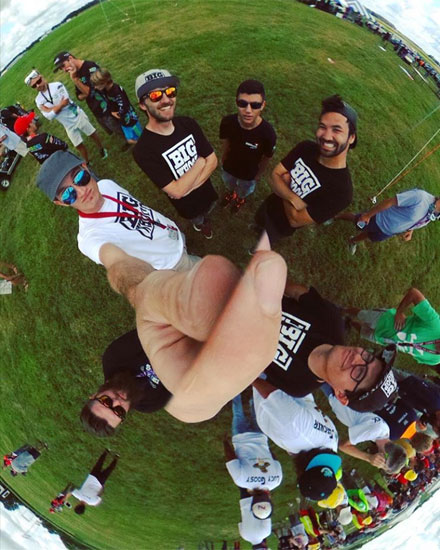
Big Whoop, photos from Instagram Jordan Temkin
"When we first started flying, I could barely know anything," Temkin told me at Fort Collins last fall. - I made my first drone based on a layout that I found on the network and printed on my 3D printer. I ordered parts for it, put everything together and started to fly. I liked it, but I crashed all the time. Today we can pawn such maneuvers that we couldn’t even dream of a couple of years ago. Partly because technology has become better, and partly because our skills have improved. ”
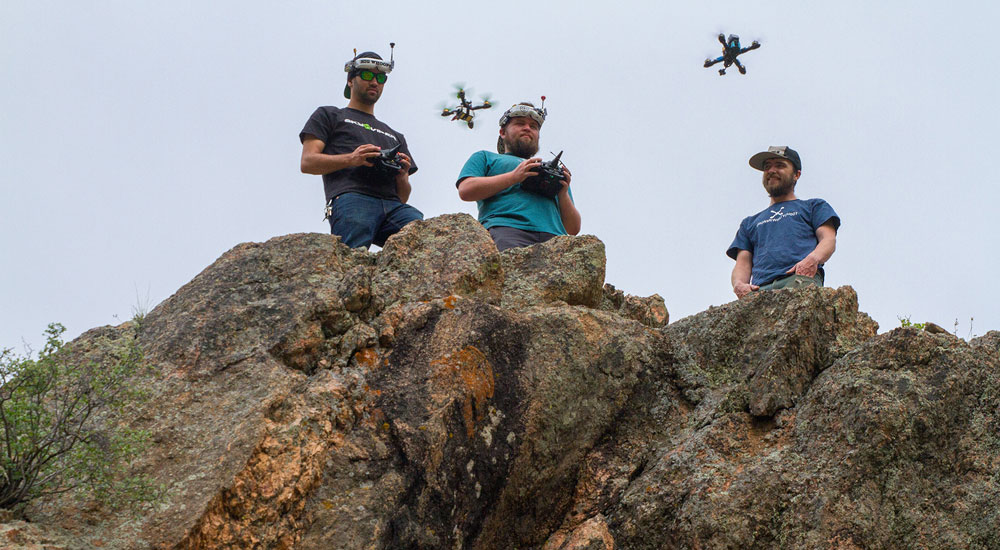
From left to right: Jordan Temkin, Zack Thayer, Travis McIntyre. Photo Engadget
Jordan and Zack (switching from surnames to their first names, which seems to suit them better) often fly with their friend and roommate, Travis McIntyre, a thin, broadly smiling little with a degree in philosophy. If Zack and Jordan fly for the sake of competition, but Travis - to unwind and it is more interesting for him to collect drones. He rarely competes with professionals. His contribution to the cause, for the most part, is carefree fun, from which Travis easily switches to a serious attitude. Big Whoop even fool around with drones in a serious way: if a drone crashes in the mountains, they go and get it. Once they attracted a couple of professional alpinists to this and climbed up the ropes with them. When they broke the drone in the river, they rented wetsuits and dived after him. Pilots claim they lost only one drone.
The world of flying drones is divided into two parts. Most people immediately think of military drones. Predator and Reaper drones, which fire rockets and are engaged in reconnaissance, are unmanned propeller aircraft equipped with internal combustion engines. Their deadliness gives the ominous word "drone". The quadcopter, the most popular type of civilian drone, flies on an electric motor powered by batteries. Usually they have four propellers, but some may have more (note: all copters with rotors are a multicopter subtype) ; Some craftsmen made drones with fifty propellers. All drones are controlled by radio signals. Many military drones receive signals sent from the ground via satellite. Other drones operate on a signal that is received from the control panel within the line of sight.
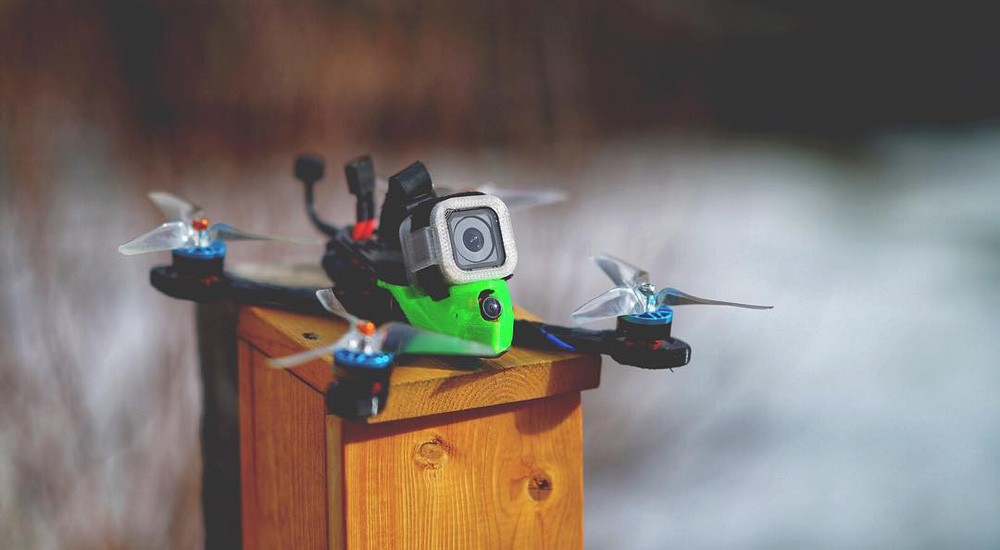
One of the self-made drone Jordan Temkin, photo from Facebook
People who control drones for fun and other peaceful purposes usually buy ready-made vehicles in stores or via the Internet. Some of these drones are big, like bedside tables. Most of the copters available in stores limit the field of vision of the pilot with direct visibility, that is, they must be controlled in the same way as radio-controlled cars or model aircraft. Drones, which are sent by pilots using an onboard camera through video glasses, allow you to maneuver much more precisely. They belong to a subcategory called FPV, which stands for the first-person view (first-person view). Drones racing in its current form would not be possible without FPV systems.

The number of quadcopters is constantly growing thanks to smartphones. In order for the image on the display of the smartphone to be correctly oriented all the time, the gadget must know which side is at the top, as well as its position vertically and horizontally. An instrument called an accelerometer, which measures the change in velocity relative to Earth’s gravity (approx. Translator: in fact, the accelerometer works a little differently ), is responsible for the first function, and the gyroscope for the second. Both of them are usually enclosed in a separate tiny component that is actively used in the development of game controllers. Smartphones popularized the technology, and their prevalence provided such a volume of production of the combined accelerometer-gyroscope module that it became cheap enough to use in quadcopters.
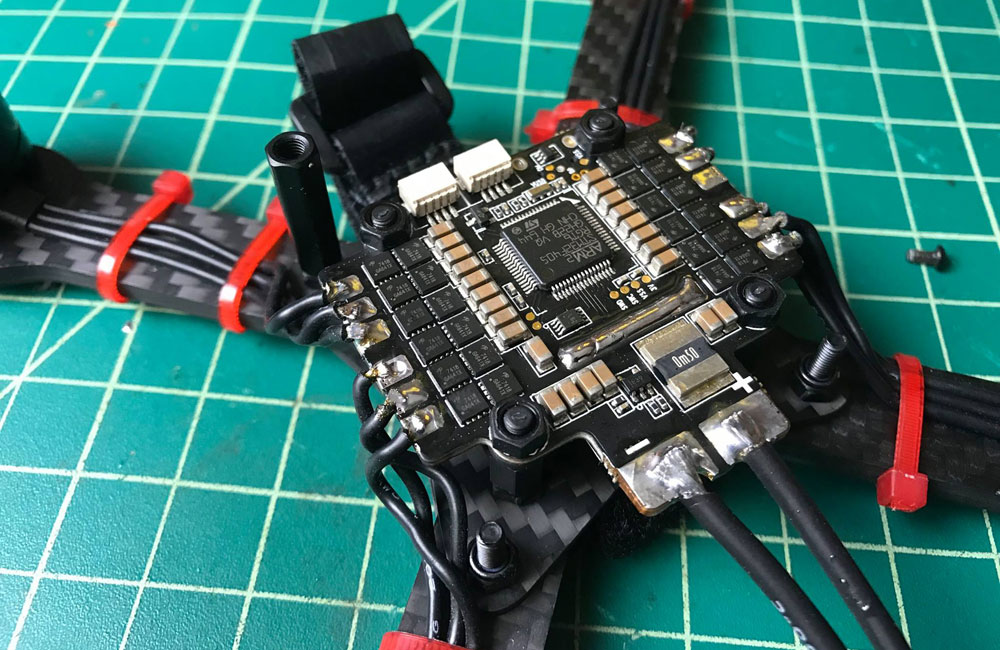
Disassembled quadrocopter, photo from Jordan Temkin's Facebook
Accelerometer and gyroscope help quadrocopter to maintain balance. Now imagine him hovering in the air, with propellers spinning parallel to the ground. The drone does not have a steering wheel and flaps to control the flight; instead, he maneuvers by adjusting the speed and, sometimes, the angle of his propellers. Commands that indicate how and when to change the rotation come through radio signals that the onboard hardware decodes into the computer code. Jordan, Zack, Travis and other Big Whoop pilots collect their own drones. The drone stabilization algorithms can be downloaded free from the Internet, but Zack can experiment and write his own code. Jordan with his art education mastered the art of soldering tiny circuits in the flight controller.
An FPV camera that broadcasts video to pilot's glasses is an analogue system. Her image lacks the sharpness of digital shooting. However, analog broadcasting comes in real time, while the digital one is a hundred milliseconds behind. Such a tiny difference is enough to prevent high-speed piloting, so on-board digital cameras are usually used for shooting video. These cameras are called GoPro - by the most popular brand. The videos they shoot are breathtaking.
If you want to know what it is like to fly at a speed of 128 km / h through abandoned steel mills, hospitals, shopping malls, warehouses and similar places, you will find on YouTube a wide selection of commercials made on GoPro. Some records from the drones will take you to the forest paths, allow you to fly with seagulls over the ocean waves, or admire the mountain canyons from the height of the eagle's flight (the latest genre specializes Big Whoop pilots). Jordan claims that he can look at the video and say who pilots the drone, because everyone has their own distinctive style. Thousands of fans are watching Jordan and Zack's videos on the net.
I saw the quadcopter first in my life about four years ago when I was walking along Fifth Avenue. He resembled one of the trays, which they put on their knees for breakfast in bed, only with propellers. He was carried by a young man, and I felt a fleeting desire to follow him. Two years later, I found a small drone on a tree in a park near my home in New Jersey. That copter was rounded and made of white plastic, about 15 centimeters across, without a camera - the typical drone of a novice. I studied him in amazement, worthy of a prehistoric man. The four drone propellers seemed intact. Looks like he didn't hit a tree. Rather, someone deliberately placed the drone here at eye level, so that the pilot who lost it could find his kopter. I considered this a good omen and put the find back in place.
The rise in popularity of drones went through an early period, when everyone who tried to control the FPV drone, without fail broke it. Shows of flying models included demonstration zones for drones, fenced from floor to ceiling with a grid like the one that can be seen on golf courses. There the pilots could have fun with their drones. At the exhibition of the Academy of Aviation Models in the corporate park of Meadowlands, the area designated for drones was indicated by the characteristic rattling sound of falling copters. Most of the demonstrations included a short flight and an unexpected drop; and then the pilots huddled together, trying to assess the damage.
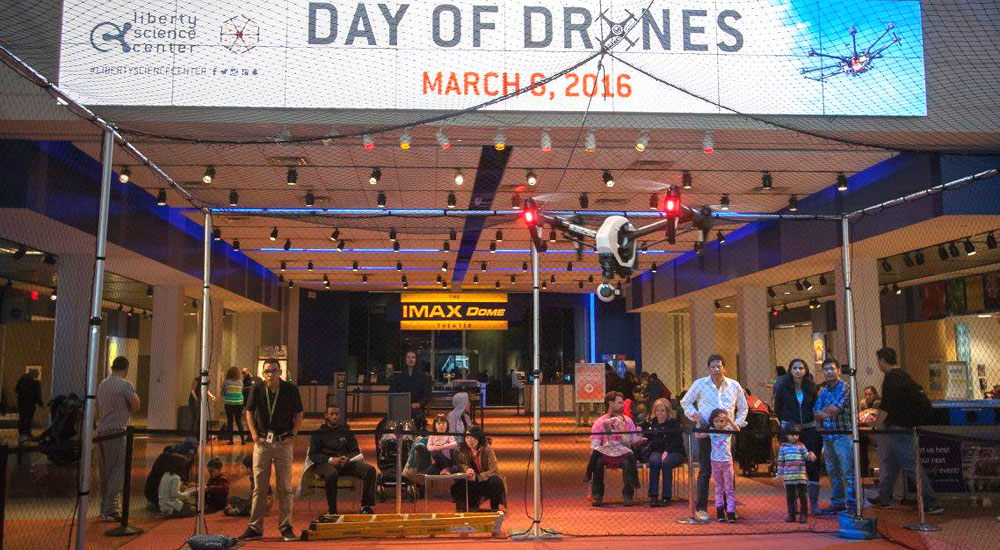
Drones Day at the Liberty Science Center in Jersey City. Photo source: official Facebook page
One Sunday at the beginning of March 2016, I visited the Drones Day at the science center in Jersey City. Then I had to go around to find a free parking space. Children of all ages and nationalities got off to look at the battles of drones (few contacts, many falls), races (even more falls, but some real races taking place on the track installed in the museum), and in the IMAX cinema there were twisted pictures York Film Festival shot on drones. Enthusiastic children swarmed everywhere, some with their own aircraft. The racers, mostly twenty-year-olds from the FPV Addiction group, gathered around them enchanted children, whose parents waited patiently nearby.
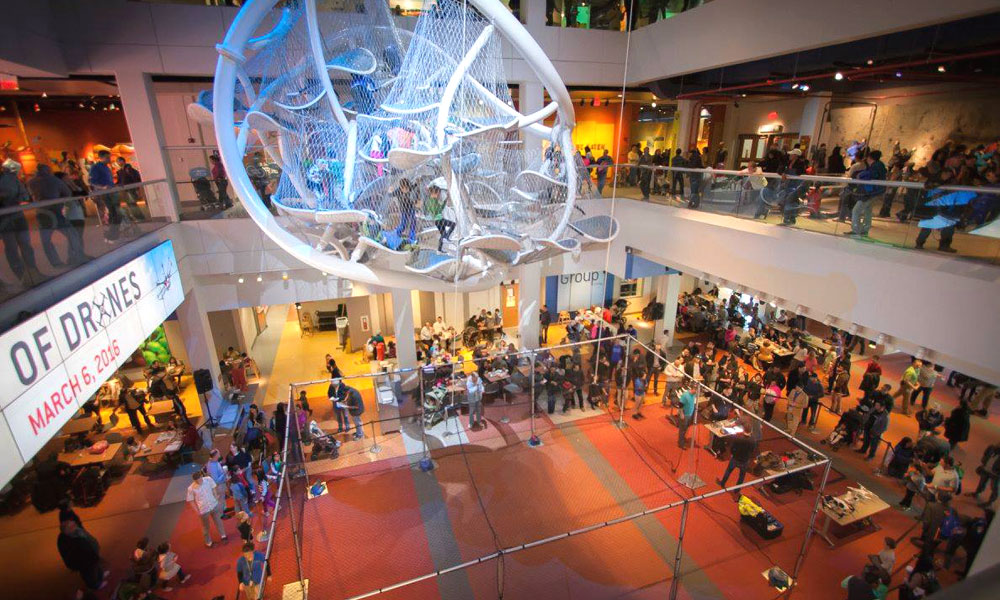
Drones Day at the Liberty Science Center in Jersey City. Photo source: official Facebook page
I first saw competitors Jordan and Zack on August 7, 2016 at an event called the US National Racing Championship on drones, which was organized by an organization called the Sports Association of Drones. At that time I knew only the nicknames of the pilots. The sports association of drones, or DSA, basically exists in the network. According to her official statement, a group of thirty pilots who participated in the championship was trained during a number of qualifying competitions throughout the country. The race track, marked with plastic rings, gates and flags, was located on a grass field on Governors Island in New York Harbor. According to the championship commentator, Wilbur Wright took off from this very field in 1909 to make his famous circled Statue of Liberty. Today will be the same historic day, claimed the commentator.

Drone Racing Championship, Governors Island, New York. Photo source: Quartz
Spectators filled the stands installed at the finish; sponsors' flags flew over the track and the platform where the pilots were sitting. Along one side of the field, commercial tents were lined up with goods belonging to the world of drones, and large monitors with split screens showed views from the participating drones cameras. There was even a VIP-box, mostly empty. The founder of the association, Scot Refsland, gave a speech. He noted that the event for the first time broadcasts a sports channel ESPN, and proclaimed the race of drones "new Nascar."

Drone Racing Championship, Governors Island, New York. Photo source: Quartz
However, the event was not the best way, because no one had worked in advance of the possible problems. Unlike the Wright brothers, who solved all their technical difficulties in securing themselves to pasture in Ohio, the organizers of the DSA race appear to have encountered some basic difficulties for the first time. So, Wi-Fi connectivity spectator smartphones filled a narrow radio frequency band, the necessary pilot to communicate with the aircraft. Establishing and maintaining open channels has proven to be a risky venture. Due to the large amount of interference, fewer pilots could compete in each race, so the number of races had to be increased. In addition, even to start had to bother a lot. Divided screens all the time clogged with "snow" and turned off. The commentator kept repeating: “If you have Wi-Fi, please turn it off ... We have problems with the radio channel ... please turn off your personal Wi-Fi and hot spots ... Do the judges have a video? .. When we finally start, everything will be so cool! Please viewers, turn off Wi-Fi. ”
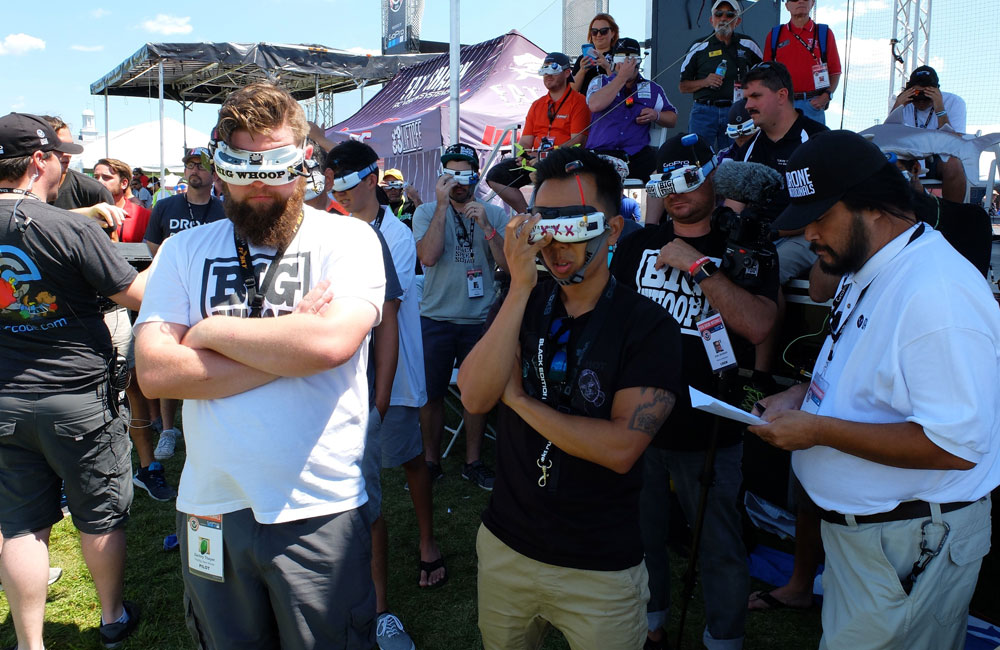
Drone Racing Championship, Governors Island, New York. Photo source: Quartz
Drones are constantly falling and going astray. Jordan's drone flew into the superstructure above the finish line and stuck in it, so the pilot had to climb up to reach it. Zach arrived at the qualifying round on the eve of a half asleep. He drove all night from Orange County, where he was the best man at the wedding. However, in a state of serious lack of sleep, he managed to surpass his surroundings, finding solace in flight. During his races in the finals, Zach sat on the platform dedicated to the pilots, swinging back and forth in time with the vision movement in the video glasses, and eventually won the first prize - ten thousand dollars, plus an additional two thousand for the freestyle competition. By the end of the evening, many viewers dispersed, and did not understand what they had just seen. Now the Sports Association of drones is either inactive or has ceased to exist.
When I visited Jordan, Zack and Travis in Fort Collins, they lived in a one-story house in the private sector, next to the open prairie. I arrived around 11am so as not to wake them up. Zack was supposed to be at home, but at the last minute he decided to attend a drone race in Seoul. He was invited there as a celebrity pilot, not a competitor. Jordan asked me to take off my shoes. I was amazed at the order in which they reigned at home. I could not even dream of anything like that in my 26 years.
The two-meter trophy shelf was central to the living room — with prizes from races in Phoenix, Detroit, Orlando, Louisville and Dubai, among other things. Some were as tall as meters and looked like abstract sculptures. The real center of the house was the basement, where I was immediately led. In America, there are tens of millions of such basements: the floor is covered with carpet, bare concrete walls, high basement windows, open air ducts and pipes under the ceiling, a boiler in the corner ... It is felt that here someone is constantly hiding from family affairs. This particular basement was filled with the roar of inventions and ambitions familiar to the Wright brothers. On the walls, instead of the usual musical posters and copies of road signs, hung a few huge checks, which give the winners for the news pictures. On some were printed race logos and four-digit amounts in the middle.

Spare parts for copters, photos from Instagram Jordan Temkin
Here and there, there were racks with shelves filled with quadrocopters. “Most of them are our unfortunate creations that weren’t working the way we wanted,” Jordan said. - This quadcopter case, for example, was my very first drone, which I printed on a 3D printer. You may notice thin lines where the printer laid the new layer. All of these twelve to fifteen boxes along the walls are filled with propellers. We spend them in the thousands. Here in this box are a bunch of packages with propellers made by one of our sponsors. ” He pulled out the package and showed the photo with him and Zach on a label resembling in design an old-fashioned box of oatmeal.

Spare parts for copters, photos from Instagram Jordan Temkin
Around lay soldering irons, extension cords, numerous boxes of batteries of varying degrees of freshness, motors for quadcopters, control panels, FPV glasses with large Fat Shark inscription (the name of the main manufacturer of such glasses), quadcopters of various sizes. It was all up to pocket mini-drones, which pilots shoot videos from the height of the insect's flight: fly around their living rooms and kitchens, maneuver between the legs of chairs and cushions of sofas and around a jar of peanut butter on the table. Such an abundance of technology gave the basement the appearance of a wizard's workshop. There was a multilevel racing trophy on the side, which seemed out of place here.
“Oh, that,” said Travis, when I asked about the cup. - Once we sat and talked, looked at him and wondered if he could fly. Well, we attached motors and propellers to it, and tested it the next day. He flew quite well, especially for the heavy, almost meter-long trophy. ”
The daily piloting of the drones formed the basis of the schedule. After lunch at an eatery in Fort Collins (wooden tables, luxury combos, homemade soda), Jordan and Travis took us on a new Hatchback Subaru WRX, owned by Jordan, to the Roosevelt National Reserve, and then on to the canyon of the Cashme River Powder The river, which is known as Puder, is one of the best places for trout fishing in the state, and there is a descent to the water every 400 meters. We stopped at a narrow passage near the canyon wall, pulled out our equipment, put on glasses and sent drones flying. The rock formations of the canyon resembled books on a bookshelf. Occasionally a stone pillar stood out like a bare book spine. Drones slid along vertical rocks, almost touching them, and then flew into a short juniper on a hillside. Their motors chatter like a sewing machine.
We had extra FPV points so that I could follow what was happening with the pilot. I came to the conclusion that it is impossible to do this without clinging tightly to the car. With each jump and dive, the first-person view in glasses makes an unused brain to anticipate a quick death. After a couple of minutes, I took off my glasses with great relief. Watching the drones without them, I first noticed a cubic black shadow pattern cast by the rocks of the canyon. While Jordan was piloting the drone, Travis told me about a flock of geese flying past, to which he tried to settle down on his drone, and how suddenly a bear appeared in front of his copter. He returned the drone to look at the beast again, but the bear didn’t seem to bother it at all.
Jordan's drone collided with a juniper branch and fell. Putting the glasses aside, the pilot quickly climbed a steep incline and returned with a drone, a battery and a GoPro camera. The crash of a drone, in which it shatters into pieces, is called a “yard sale,” the same term designating the fall of a skier who lost his gear in the process. Jordan was engaged in ski acrobatics, but in late adolescence he abandoned the sport, after accidentally breaking his knee on his own head and lain in bed for a month. Like many other pilots of drones, he replaced the intense physical sport with one where you bump into something only indirectly.
Zack showed up at home the next morning, after a night flight from South Korea. Apparently, he did not notice the change of time zones. The newcomer was sitting on the sofa in his living room in a T-shirt and a pair of baggy black pants, decorated with white patterns from Star Wars attack aircraft, and praised the South Korean government, which encourages the development of UAV technology. The authorities have established a public park for drones on the outskirts of Seoul and hold regular drone races that are visited by thousands of people. In Korean schools in the framework of STEM-programs distribute instructions for assembling drones. “Friendly people, great food, a fun nightlife in Times Square in Seoul, lots of fans of drone racing,” Zac said. “South Korea is one of the best countries in the world for UAVs.”
Video shot by Zach Thayer in South Korea.
“At the international level, Koreans on average are the best pilots. I’m most afraid of them as rivals, ”Jordan added.
I especially wanted to ask Zack about the video I saw on the Internet, where the drone competed with electric cars. Zach ruled that drone.
“Yes, it was awesome,” he said, laughing. - It happened last summer during the two-day Formula E race on the highway in Brooklyn, in the Red Hook area. We competed against an electric car on a drone that we assembled ourselves. The drone was three square feet in size, weighed 18 kilograms, and made a terrifying roar — you could feel it tearing through the air. It accelerated to 177 km / h. Drones do not need time to accelerate, because they reach maximum speed almost instantly. After the start, I left the electric car so far behind that it seemed that it was not moving. The drone was going great, but then it began to scour, there was not enough space to slow down. This overloaded the system, which was not intended for such a healthy drone. I was scared that I could not land it safely, so I let it climb up and then flew straight into the track. He broke into about a million pieces and earned the loudest applause for that weekend. ”
The end of the first part. The second you can read on this link .



In a canyon in the foothills of the Rockies, near Fort Collins, Colorado, a young man named Jordan Temkin runs a drone. On Temkin video glasses that broadcast video from a camera built into the drone, and in his hands he holds a console with a pair of joysticks that control the direction, roll, pitch, yaw, and flight speed. The pilot puts the drone on the gravel at his feet. Just below the river flows the Cash-la-Paudre. The canyon slopes rise ninety meters above it. Temkin gives the command, and the drone instantly takes off to the top of the canyon. Then he soars above, from where a person seems to be a small figure sitting aboard a car. The shadow of the drone flashes on the surface of the rocks, sweeping at a speed of 128 km / h. Then the pilot lowers the apparatus to the river and he flies half a meter from the water. The river shimmers with silver in the sun. Temkin again raises the drone higher and turns into a nearby canyon.
The stock of the battery powering the drone is about three minutes. Before the time comes, Temkin lowers the drone next to him. Landing on the gravel sounds like a knock from dropping a plastic toy. Yes, and the drone itself looks like a toy. Temkin calls him a "quadrocopter." The quadcopter has four plastic propellers, each at the corner of a cruciform plastic frame. Usually such drones are called “quads”. The whole device would easily fit in the package for one slice of pizza. An immeasurable amount of scientific and technical discoveries, like a huge inverted pyramid, converge at this tiny, toy point.

Jordan Temkin, photo by Engadget
')
At twenty-six, Temkin retained those sweet, serene manners of a beloved child, but not a spoiled child. He is about eighty meters tall, dark-haired, with Asian features. Dressed in black jeans, a black T-shirt with a small silver “DRL” emblem, a dark blue sweatshirt with open zipper, and white and yellow sneakers. When people ask Temkin what he does for a living, he answers that he controls toy helicopters. He concluded that this is a good description of his new vocation. Temkin is a professional drone pilot, one of the best in the new sport. To practice, he flies in the mountains as often as he can.
Temkin often flies with Zahri Thayer, his housemate in Fort Collins, other professional pilots. Thayer is somewhat denser than Temkin, with magical blue eyes and a full beard. Both come from the west coast of the United States: Temkin from Seattle, and Thayer from Laguna-Niguel, from Orange County in California. They met at the dacon race in Sacramento in 2015, where they were rivals. Temkin graduated from the University of Colorado with a humanitarian degree and was looking for someone to rent a house with, so the pilots decided to live together. In the network Temkin found other local lovers of piloting drones. A bunch of local enthusiasts united in a group of "Big Whoop", so called, because at first they were not very impressive pilots. The current successes of Temkin and Tayer gave this name shine. Temkin participates in races under the pseudonym "Jet", formed from his initials. Thayer has a different nickname - A_Nub, which originally meant a “newcomer”, which Thayer is no longer. He retained the nickname because it was under him that he gained fame among fans of drones racing.

Big Whoop, photos from Instagram Jordan Temkin
"When we first started flying, I could barely know anything," Temkin told me at Fort Collins last fall. - I made my first drone based on a layout that I found on the network and printed on my 3D printer. I ordered parts for it, put everything together and started to fly. I liked it, but I crashed all the time. Today we can pawn such maneuvers that we couldn’t even dream of a couple of years ago. Partly because technology has become better, and partly because our skills have improved. ”

From left to right: Jordan Temkin, Zack Thayer, Travis McIntyre. Photo Engadget
Jordan and Zack (switching from surnames to their first names, which seems to suit them better) often fly with their friend and roommate, Travis McIntyre, a thin, broadly smiling little with a degree in philosophy. If Zack and Jordan fly for the sake of competition, but Travis - to unwind and it is more interesting for him to collect drones. He rarely competes with professionals. His contribution to the cause, for the most part, is carefree fun, from which Travis easily switches to a serious attitude. Big Whoop even fool around with drones in a serious way: if a drone crashes in the mountains, they go and get it. Once they attracted a couple of professional alpinists to this and climbed up the ropes with them. When they broke the drone in the river, they rented wetsuits and dived after him. Pilots claim they lost only one drone.
The world of flying drones is divided into two parts. Most people immediately think of military drones. Predator and Reaper drones, which fire rockets and are engaged in reconnaissance, are unmanned propeller aircraft equipped with internal combustion engines. Their deadliness gives the ominous word "drone". The quadcopter, the most popular type of civilian drone, flies on an electric motor powered by batteries. Usually they have four propellers, but some may have more (note: all copters with rotors are a multicopter subtype) ; Some craftsmen made drones with fifty propellers. All drones are controlled by radio signals. Many military drones receive signals sent from the ground via satellite. Other drones operate on a signal that is received from the control panel within the line of sight.

One of the self-made drone Jordan Temkin, photo from Facebook
People who control drones for fun and other peaceful purposes usually buy ready-made vehicles in stores or via the Internet. Some of these drones are big, like bedside tables. Most of the copters available in stores limit the field of vision of the pilot with direct visibility, that is, they must be controlled in the same way as radio-controlled cars or model aircraft. Drones, which are sent by pilots using an onboard camera through video glasses, allow you to maneuver much more precisely. They belong to a subcategory called FPV, which stands for the first-person view (first-person view). Drones racing in its current form would not be possible without FPV systems.

The number of quadcopters is constantly growing thanks to smartphones. In order for the image on the display of the smartphone to be correctly oriented all the time, the gadget must know which side is at the top, as well as its position vertically and horizontally. An instrument called an accelerometer, which measures the change in velocity relative to Earth’s gravity (approx. Translator: in fact, the accelerometer works a little differently ), is responsible for the first function, and the gyroscope for the second. Both of them are usually enclosed in a separate tiny component that is actively used in the development of game controllers. Smartphones popularized the technology, and their prevalence provided such a volume of production of the combined accelerometer-gyroscope module that it became cheap enough to use in quadcopters.

Disassembled quadrocopter, photo from Jordan Temkin's Facebook
Accelerometer and gyroscope help quadrocopter to maintain balance. Now imagine him hovering in the air, with propellers spinning parallel to the ground. The drone does not have a steering wheel and flaps to control the flight; instead, he maneuvers by adjusting the speed and, sometimes, the angle of his propellers. Commands that indicate how and when to change the rotation come through radio signals that the onboard hardware decodes into the computer code. Jordan, Zack, Travis and other Big Whoop pilots collect their own drones. The drone stabilization algorithms can be downloaded free from the Internet, but Zack can experiment and write his own code. Jordan with his art education mastered the art of soldering tiny circuits in the flight controller.
An FPV camera that broadcasts video to pilot's glasses is an analogue system. Her image lacks the sharpness of digital shooting. However, analog broadcasting comes in real time, while the digital one is a hundred milliseconds behind. Such a tiny difference is enough to prevent high-speed piloting, so on-board digital cameras are usually used for shooting video. These cameras are called GoPro - by the most popular brand. The videos they shoot are breathtaking.
If you want to know what it is like to fly at a speed of 128 km / h through abandoned steel mills, hospitals, shopping malls, warehouses and similar places, you will find on YouTube a wide selection of commercials made on GoPro. Some records from the drones will take you to the forest paths, allow you to fly with seagulls over the ocean waves, or admire the mountain canyons from the height of the eagle's flight (the latest genre specializes Big Whoop pilots). Jordan claims that he can look at the video and say who pilots the drone, because everyone has their own distinctive style. Thousands of fans are watching Jordan and Zack's videos on the net.
I saw the quadcopter first in my life about four years ago when I was walking along Fifth Avenue. He resembled one of the trays, which they put on their knees for breakfast in bed, only with propellers. He was carried by a young man, and I felt a fleeting desire to follow him. Two years later, I found a small drone on a tree in a park near my home in New Jersey. That copter was rounded and made of white plastic, about 15 centimeters across, without a camera - the typical drone of a novice. I studied him in amazement, worthy of a prehistoric man. The four drone propellers seemed intact. Looks like he didn't hit a tree. Rather, someone deliberately placed the drone here at eye level, so that the pilot who lost it could find his kopter. I considered this a good omen and put the find back in place.
The rise in popularity of drones went through an early period, when everyone who tried to control the FPV drone, without fail broke it. Shows of flying models included demonstration zones for drones, fenced from floor to ceiling with a grid like the one that can be seen on golf courses. There the pilots could have fun with their drones. At the exhibition of the Academy of Aviation Models in the corporate park of Meadowlands, the area designated for drones was indicated by the characteristic rattling sound of falling copters. Most of the demonstrations included a short flight and an unexpected drop; and then the pilots huddled together, trying to assess the damage.

Drones Day at the Liberty Science Center in Jersey City. Photo source: official Facebook page
One Sunday at the beginning of March 2016, I visited the Drones Day at the science center in Jersey City. Then I had to go around to find a free parking space. Children of all ages and nationalities got off to look at the battles of drones (few contacts, many falls), races (even more falls, but some real races taking place on the track installed in the museum), and in the IMAX cinema there were twisted pictures York Film Festival shot on drones. Enthusiastic children swarmed everywhere, some with their own aircraft. The racers, mostly twenty-year-olds from the FPV Addiction group, gathered around them enchanted children, whose parents waited patiently nearby.

Drones Day at the Liberty Science Center in Jersey City. Photo source: official Facebook page
I first saw competitors Jordan and Zack on August 7, 2016 at an event called the US National Racing Championship on drones, which was organized by an organization called the Sports Association of Drones. At that time I knew only the nicknames of the pilots. The sports association of drones, or DSA, basically exists in the network. According to her official statement, a group of thirty pilots who participated in the championship was trained during a number of qualifying competitions throughout the country. The race track, marked with plastic rings, gates and flags, was located on a grass field on Governors Island in New York Harbor. According to the championship commentator, Wilbur Wright took off from this very field in 1909 to make his famous circled Statue of Liberty. Today will be the same historic day, claimed the commentator.

Drone Racing Championship, Governors Island, New York. Photo source: Quartz
Spectators filled the stands installed at the finish; sponsors' flags flew over the track and the platform where the pilots were sitting. Along one side of the field, commercial tents were lined up with goods belonging to the world of drones, and large monitors with split screens showed views from the participating drones cameras. There was even a VIP-box, mostly empty. The founder of the association, Scot Refsland, gave a speech. He noted that the event for the first time broadcasts a sports channel ESPN, and proclaimed the race of drones "new Nascar."

Drone Racing Championship, Governors Island, New York. Photo source: Quartz
However, the event was not the best way, because no one had worked in advance of the possible problems. Unlike the Wright brothers, who solved all their technical difficulties in securing themselves to pasture in Ohio, the organizers of the DSA race appear to have encountered some basic difficulties for the first time. So, Wi-Fi connectivity spectator smartphones filled a narrow radio frequency band, the necessary pilot to communicate with the aircraft. Establishing and maintaining open channels has proven to be a risky venture. Due to the large amount of interference, fewer pilots could compete in each race, so the number of races had to be increased. In addition, even to start had to bother a lot. Divided screens all the time clogged with "snow" and turned off. The commentator kept repeating: “If you have Wi-Fi, please turn it off ... We have problems with the radio channel ... please turn off your personal Wi-Fi and hot spots ... Do the judges have a video? .. When we finally start, everything will be so cool! Please viewers, turn off Wi-Fi. ”

Drone Racing Championship, Governors Island, New York. Photo source: Quartz
Drones are constantly falling and going astray. Jordan's drone flew into the superstructure above the finish line and stuck in it, so the pilot had to climb up to reach it. Zach arrived at the qualifying round on the eve of a half asleep. He drove all night from Orange County, where he was the best man at the wedding. However, in a state of serious lack of sleep, he managed to surpass his surroundings, finding solace in flight. During his races in the finals, Zach sat on the platform dedicated to the pilots, swinging back and forth in time with the vision movement in the video glasses, and eventually won the first prize - ten thousand dollars, plus an additional two thousand for the freestyle competition. By the end of the evening, many viewers dispersed, and did not understand what they had just seen. Now the Sports Association of drones is either inactive or has ceased to exist.
When I visited Jordan, Zack and Travis in Fort Collins, they lived in a one-story house in the private sector, next to the open prairie. I arrived around 11am so as not to wake them up. Zack was supposed to be at home, but at the last minute he decided to attend a drone race in Seoul. He was invited there as a celebrity pilot, not a competitor. Jordan asked me to take off my shoes. I was amazed at the order in which they reigned at home. I could not even dream of anything like that in my 26 years.
The two-meter trophy shelf was central to the living room — with prizes from races in Phoenix, Detroit, Orlando, Louisville and Dubai, among other things. Some were as tall as meters and looked like abstract sculptures. The real center of the house was the basement, where I was immediately led. In America, there are tens of millions of such basements: the floor is covered with carpet, bare concrete walls, high basement windows, open air ducts and pipes under the ceiling, a boiler in the corner ... It is felt that here someone is constantly hiding from family affairs. This particular basement was filled with the roar of inventions and ambitions familiar to the Wright brothers. On the walls, instead of the usual musical posters and copies of road signs, hung a few huge checks, which give the winners for the news pictures. On some were printed race logos and four-digit amounts in the middle.

Spare parts for copters, photos from Instagram Jordan Temkin
Here and there, there were racks with shelves filled with quadrocopters. “Most of them are our unfortunate creations that weren’t working the way we wanted,” Jordan said. - This quadcopter case, for example, was my very first drone, which I printed on a 3D printer. You may notice thin lines where the printer laid the new layer. All of these twelve to fifteen boxes along the walls are filled with propellers. We spend them in the thousands. Here in this box are a bunch of packages with propellers made by one of our sponsors. ” He pulled out the package and showed the photo with him and Zach on a label resembling in design an old-fashioned box of oatmeal.

Spare parts for copters, photos from Instagram Jordan Temkin
Around lay soldering irons, extension cords, numerous boxes of batteries of varying degrees of freshness, motors for quadcopters, control panels, FPV glasses with large Fat Shark inscription (the name of the main manufacturer of such glasses), quadcopters of various sizes. It was all up to pocket mini-drones, which pilots shoot videos from the height of the insect's flight: fly around their living rooms and kitchens, maneuver between the legs of chairs and cushions of sofas and around a jar of peanut butter on the table. Such an abundance of technology gave the basement the appearance of a wizard's workshop. There was a multilevel racing trophy on the side, which seemed out of place here.
“Oh, that,” said Travis, when I asked about the cup. - Once we sat and talked, looked at him and wondered if he could fly. Well, we attached motors and propellers to it, and tested it the next day. He flew quite well, especially for the heavy, almost meter-long trophy. ”
The daily piloting of the drones formed the basis of the schedule. After lunch at an eatery in Fort Collins (wooden tables, luxury combos, homemade soda), Jordan and Travis took us on a new Hatchback Subaru WRX, owned by Jordan, to the Roosevelt National Reserve, and then on to the canyon of the Cashme River Powder The river, which is known as Puder, is one of the best places for trout fishing in the state, and there is a descent to the water every 400 meters. We stopped at a narrow passage near the canyon wall, pulled out our equipment, put on glasses and sent drones flying. The rock formations of the canyon resembled books on a bookshelf. Occasionally a stone pillar stood out like a bare book spine. Drones slid along vertical rocks, almost touching them, and then flew into a short juniper on a hillside. Their motors chatter like a sewing machine.
We had extra FPV points so that I could follow what was happening with the pilot. I came to the conclusion that it is impossible to do this without clinging tightly to the car. With each jump and dive, the first-person view in glasses makes an unused brain to anticipate a quick death. After a couple of minutes, I took off my glasses with great relief. Watching the drones without them, I first noticed a cubic black shadow pattern cast by the rocks of the canyon. While Jordan was piloting the drone, Travis told me about a flock of geese flying past, to which he tried to settle down on his drone, and how suddenly a bear appeared in front of his copter. He returned the drone to look at the beast again, but the bear didn’t seem to bother it at all.
Jordan's drone collided with a juniper branch and fell. Putting the glasses aside, the pilot quickly climbed a steep incline and returned with a drone, a battery and a GoPro camera. The crash of a drone, in which it shatters into pieces, is called a “yard sale,” the same term designating the fall of a skier who lost his gear in the process. Jordan was engaged in ski acrobatics, but in late adolescence he abandoned the sport, after accidentally breaking his knee on his own head and lain in bed for a month. Like many other pilots of drones, he replaced the intense physical sport with one where you bump into something only indirectly.
Zack showed up at home the next morning, after a night flight from South Korea. Apparently, he did not notice the change of time zones. The newcomer was sitting on the sofa in his living room in a T-shirt and a pair of baggy black pants, decorated with white patterns from Star Wars attack aircraft, and praised the South Korean government, which encourages the development of UAV technology. The authorities have established a public park for drones on the outskirts of Seoul and hold regular drone races that are visited by thousands of people. In Korean schools in the framework of STEM-programs distribute instructions for assembling drones. “Friendly people, great food, a fun nightlife in Times Square in Seoul, lots of fans of drone racing,” Zac said. “South Korea is one of the best countries in the world for UAVs.”
Video shot by Zach Thayer in South Korea.
“At the international level, Koreans on average are the best pilots. I’m most afraid of them as rivals, ”Jordan added.
I especially wanted to ask Zack about the video I saw on the Internet, where the drone competed with electric cars. Zach ruled that drone.
“Yes, it was awesome,” he said, laughing. - It happened last summer during the two-day Formula E race on the highway in Brooklyn, in the Red Hook area. We competed against an electric car on a drone that we assembled ourselves. The drone was three square feet in size, weighed 18 kilograms, and made a terrifying roar — you could feel it tearing through the air. It accelerated to 177 km / h. Drones do not need time to accelerate, because they reach maximum speed almost instantly. After the start, I left the electric car so far behind that it seemed that it was not moving. The drone was going great, but then it began to scour, there was not enough space to slow down. This overloaded the system, which was not intended for such a healthy drone. I was scared that I could not land it safely, so I let it climb up and then flew straight into the track. He broke into about a million pieces and earned the loudest applause for that weekend. ”
The end of the first part. The second you can read on this link .


Source: https://habr.com/ru/post/371309/
All Articles